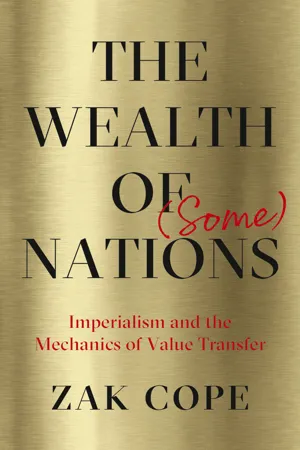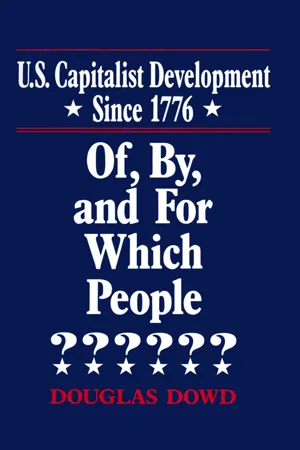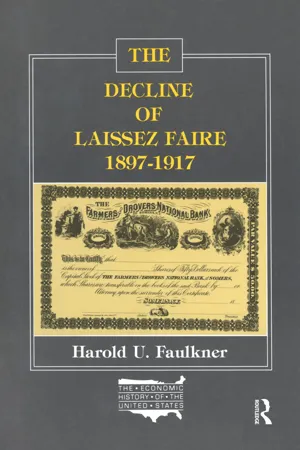History
Economic Imperialism
Economic imperialism refers to the economic dominance and control exerted by one country or group over others, often through trade, investment, or resource exploitation. This can lead to unequal power dynamics and economic dependency, impacting the social, political, and cultural aspects of the dominated regions. It has been a significant force in shaping global economic relationships and historical developments.
Written by Perlego with AI-assistance
Related key terms
8 Key excerpts on "Economic Imperialism"
- eBook - ePub
- Robert J. C. Young(Author)
- 2015(Publication Date)
- Wiley-Blackwell(Publisher)
Initially this was effected by setting up infrastructure and encouraging exploitation of natural resources and industrialization by private enterprise, but in later years colonial bureaucrats and economists moved to planning and direct investment by the colonial government in areas that included social welfare and ecology. Whereas earlier analysts, such as Benjamin Kidd (1898), had considered tropical countries only in terms of the commodities that they made available to Europe and the United States, from the 1930s economists saw the advantages of the colonies developing their own economies by increasing their productivity and therefore becoming less of a drain on imperial resources (Meredith and Havinden 2002; Hansen and Jonsson 2013). Imperialism without Colonies In response to the cost and the increasing impracticality of empire, around the end of the nineteenth century a different and more efficient kind of imperialism emerged that reestablished unashamedly economic priorities. As mentioned in the introduction to this chapter, whereas imperialism originally meant conquest and military occupation, directed from the center, by the end of the nineteenth century a new meaning had developed in which imperialism was linked to economic power reinforced by military strength, diplomatic pressure, and cultural influence, without necessarily involving territorial acquisition and physical occupation. This second kind of imperialism, of imperialism without colonies, was and still is often used in relation to the United States, and is associated with US policy in the Caribbean and South America. Although the United States began to acquire colonies in the Pacific from the mid-nineteenth century, it found that, having established South America as its sphere of influence with the Monroe Doctrine, it was able to exert economic pressure through trade alone - eBook - ePub
The Wealth of (Some) Nations
Imperialism and the Mechanics of Value Transfer
- Zak Cope(Author)
- 2019(Publication Date)
- Pluto Press(Publisher)
Nominally, imperialist economies are those which operate internationally on the basis of a net transfer of value from specified foreign territories, while exploited countries are net exporters of value to said foreign territories. This transfer is effected through monopolistic control of global value chains in agriculture, industry and services, as well as rents accruing to financial, mineral and physical force monopolies. In addition, monopoly capital places an effective levy on trade and investment between countries with highly divergent wage levels, with low-wage countries made to supply substantially more of their socially necessary embodied labour in trade with high-wage countries. In real terms, however, this one-sided relationship between countries or groups of countries has progressed to such an extent that the major imperialist economies today, dominated by the largest capitalist interests in the world, are able to secure a net value transfer to their economies from abroad, that is, they import more value than they create nationally, including from other nominally imperialist economies. The consumer economy attendant to imperialism is most visible in those countries that have achieved global hegemony. By contrast, even smaller imperialist countries like China are massive net exporters of national wealth to the major imperialist countries, both in terms of exchange value (labour time) and in terms of price (net current transfers from abroad, equal to the unrequited transfers of income from non-residents to residents minus the unrequited transfers from residents to non-residents). Unequal exchange in the strict sense is, of course, diminished in trade between countries with comparable wage levels, though non-equivalent exchange based on industrial or financial monopoly is not - eBook - ePub
US Capitalist Development Since 1776: Of, by and for Which People?
Of, by and for Which People?
- Douglas Dowd(Author)
- 2016(Publication Date)
- Routledge(Publisher)
at all, let alone as the world's leading imperialist nation. Yet we are that nation, and have become so in the very processes that made it possible and necessary for the United States to organize the integrated world economy of the last few decades—in the absence of which, it is fair to say, the history of those decades (and, of course, of capitalism itself) would have been vastly different—if unknowably so.One reason our people so quickly deny the imperial status of the United States is the almost universal lack of understanding of what imperialism is and does. Preceding chapters have sought to shed light on the meaning of capitalism; now we must explore the development and the nature of imperialism.Like capitalism, imperialism is a histoncal process. To attempt a oneline definition of it is to promote more confusion than enlightenment. Our attempt to clarify the concept and the reality will move analytically and historically within the framework of several related questions: When and why does a society expand its influence and control over other areas? Where is it able and likely to do so? What does the relationship mean to the imperialist and to the imperialized societies? How are the relationships developed and maintained, and how and why do they change in nature and in meaning over time? Who benefits and who pays, at either end of the relationship? In seeking to answer these questions, we shall first set forth a very general statement, and then explore the specific historical developments preceding and accompanying the emergence of the United States as the great power it became.8Imperialism: Becoming and Being
The seeds of both capitalism and nationalism are to be found in the medieval trading cities, such as Florence, Milan, and Venice, London, Bruges, and Cologne. So are the seeds of mercantilism and modern - eBook - ePub
Imperialism
A Study
- J.A. Hobson(Author)
- 2018(Publication Date)
- Routledge(Publisher)
PART I THE ECONOMICS OF IMPERIALISMPassage contains an image CHAPTER I THE MEASURE OF IMPERIALISM
Q UIBBLES about the modern meaning of the term Imperialism are best resolved by reference to concrete facts in the history of the last sixty years. During that period a number of European nations, Great Britain being first and foremost, annexed or otherwise asserted political sway over vast portions of Africa and Asia, and over numerous islands in the Pacific and elsewhere. The extent to which this policy of expansion was carried on, and in particular the enormous size and the peculiar character of the British acquisitions, were not adequately realized even by those who pay some attention to Imperial politics.The following lists, giving the area and, where possible, the population of the new acquisitions, are designed to give definiteness to the term Imperialism. Though derived from official sources, they do not, however, profess strict accuracy. The sliding scale of political terminology along which no-man’s land, or hinterland, passes into some kind of definite protectorate is often applied so as to conceal the process; “rectification” of a fluid frontier is continually taking place; paper “partitions” of spheres of influence or protection in Africa and Asia are often obscure, and in some cases the area and the population are highly speculative.In a few instances it is possible that portions of territory put down as acquired after 1870 may have been ear-marked by a European Power at some earlier date. But care is taken to include only such territories as have come within this period under the definite political control of the Power to which they are assigned. The figures in the case of Great Britain are so startling as to call for a little further interpretation. I have thought it right to add to the recognized list of colonies and protectorates1 - Bernard S. Katz, Ronald E. Robbins(Authors)
- 2017(Publication Date)
- Routledge(Publisher)
Pushing this thesis one step forward, the precondition for a truly “favorable” investment climate is indirect or direct control of internal politics in the backward regions. Economic penetration therefore leads to the establishment of spheres of influence, protectorates, and annexation. Strachey suggests that the backward regions assumed a dependency status (last step before outright control) in relation to the metropolitan powers chiefly because the former were in debt to capital goods in world trade was the colony-to-be needed long-term credits or loans to pay for the capital goods, and that, finally, the relationship between the backward country and the metropolitan country became one of debtor and creditor, and from this it was but a small step to dependence and domination.Whatever the exact sequence of events which led to colonialism, Lenin’s economic definition of colonialism (and imperialism) is monopolistically regulated trade and/or investment abroad at higher rates of profits than those obtained in the metropolitan country. “As soon as political control arrives as handmaid to investment,” Dobb writes, “the opportunity for monopolistic and preferential practices exists.” The essential ingredient of colonialism therefore is “privileged investment: namely, investment in projects which carry with them some differential advantage, preference, or actual monopoly, in the form of concession-rights or some grant of privileged status.”13The criticisms of Hobson’s and Lenin’s theories, and the alternative views which have been put forward, do not constitute a new theory so much as a catalogue of historical facts which are not fully consistent with the older theories. These criticisms bear on three key aspects of Lenin’s theory, two of which also figured importantly in Hobson’s thought.One line of criticism is that Lenin ignored the theme of continuity in European expansionism and was too eager to interpret the partition of Africa and the Pacific as a qualitatively different phenomenon. Alexander Kemp has shown that throughout the entire nineteenth century British net capital exports in relation to national income amounted to just over 1 percent during recession periods and about 6 to 7 percent during boom years.14 Pointing to a similar conclusion is Richard Koebner’s judgement that British “imperial responsibilities were enlarged step by step by a hesitant government.”15 Gallagher and Robinson also reject the idea that there were important qualitative differences between British expansionism in the first and second parts of the nineteenth century. In both periods the formula was “trade with informal control if possible; trade with the rule if necessary.”16- eBook - ePub
The Changing Face of Imperialism
Colonialism to Contemporary Capitalism
- Sunanda Sen, Maria Cristina Marcuzzo(Authors)
- 2018(Publication Date)
- Routledge India(Publisher)
competitive market economy without which global capitalism cannot be realized. This tooth and claw approach deployed to secure the subjugation of nation-states, regions and the working class to the dictate and principle of this vital connection can be described, for convenience sake, as ‘external’ imperialism. The name is appropriate for it refers to the policy of conquest in some connection to global capital or its interests that transpire at the hinge of the global order and nation states, a hinge that connects them, and through that connection makes and remakes both. Let me expand further.The imperialist policy of conquest of national states (using visible and subtle force and at times even explicit violence) has characterised much of what is known as ‘reforms’; ‘reforms’ is a name for a set of policies to alter the socio-economic structural conditions of existence of countries who are embracing or made to embrace capitalism in the mentioned direction. The role of international agencies such International Monetary Funds, World Bank and World Trade Organization, no doubt influenced and shaped by the United States and its partners, was vital in introducing this new global architecture. The last three decades have been witness to the combination of political, diplomatic and military strategies used by these global and regional powers to generate a situation which made it difficult and costly for smaller or weaker individual nation states to remain isolated; at times, outright occupation or intervention have directly played a role in integrating nation-states into the global order. The ruling disposition in some countries also saw this as an opportunity to take advantage of gains from trade, technology transfer and higher growth possibility. Whatever the reason of integration, the end result was neoliberal globalisation. A question though remains: what is the fundamental difference between this historical stage and colonial times? Instead of the humanist mission driven by the theme of ‘Civilisation, Christianity and Commerce deployed in colonial times, today, for the imperial presidencies of Reagan, Bush I, Clinton, Bush II, the mission can be summed up as “Democracy, Anticommunism and Free Trade” ’;18 we may add to that Islamophobia. A repertoire of logics, modes of reasoning, strategies, techniques of imposing pressure and mechanisms of consent generation (including using military, aid, debt, oil, and fracking as a geopolitical device), occupation, war and others are combined to fulfil this humanist mission of the contemporary. Moreover, the underlying principle of this global order, including competitive market economy and a suspicion towards protection, has also given rise to regional economic orders like NAFTA, ASEAN, the Trans-Pacific Partnership Free Trade Agreement, MERCUSOR and others alongside the European Union. This was unlike anything that existed during colonial times. The relation between the global and regional architecture intersect, compensate and reinforce one another; depending on the underlying objective of the nation states and regions, they also can be the ground of contradiction and conflict, as for example, between Greece and the European Union. Taken together, this reorganisation of global order, regional order and national policy paradigm can be described as the primary architecture of ‘external imperialism’ or of resistance to it at that level. That is one reason why some scholars consider imperialism less as a description and ‘more as a project in (this) world; an attempt to make and remake that world’.19 - eBook - ePub
- Harold Underwood Faulkner(Author)
- 2017(Publication Date)
- Routledge(Publisher)
The Development of Economic ImperialismBackground of Expansion
IN the field of foreign relations the two decades 1897-1917 marked a new era in American history. These were years when American capital began to move aggressively outside the continental boundary lines, and the United States shifted from the status of a debtor nation to that of a creditor. This export of capital was consistently encouraged by the government in the Caribbean and the Far East, but in Mexico and Canada, the two chief outlets, the movement was quite voluntary and received little or no official backing. Although the Spanish-American War gave great impetus to the export of capital, particularly in the Caribbean, the war was not promoted by business interests. The real background of American imperialism seems to rest essentially on three factors: the economic development of the United States, the fact that the federal government from 1897 to 1913 was controlled by groups who favored expansion into foreign areas, and the belief that the United States must exercise control over the Caribbean area to build and defend a canal.By 1897 the economic development of the country had reached a stage where the domestic market was being supplied with manufactured as well as agricultural goods, and surpluses of commodities were seeking foreign markets. A certain proportion of American capital also found reasons for seeking foreign investment. Moreover, there were certain commodities which this country did not have in sufficient quantities, and which tempted capitalists to move elsewhere to obtain them. The frontier of good agricultural land had been occupied, industrial equipment created, and a transportation system largely built. Already the United States had become the greatest manufacturing nation in the world, equipped with the largest railroad mileage and producing the largest amount of agricultural products. By 1898 it was the richest and economically the most powerful nation in the world. Although foreign capital continued to seek investment in America, the United States itself had reached a position in the economic world in which she could normally break from the position of a continental country concerned almost entirely with internal problems to one possessing foreign colonies and interested in the exploitation of foreign resources. - eBook - ePub
The Origins of Economic Inequality Between Nations
A Critique of Western Theories on Development and Underdevelopment
- Carlos Ramirez-Faria(Author)
- 2012(Publication Date)
- Routledge(Publisher)
It was also a proclamation to the effect that the world at large (powers such as the USA and Japan excepted) was to be the battleground of the European empires. Given the bluntness of its approach, social imperialism could never become the official state policy of any European power; it was, like eugenics at first, a purely intellectual proposition. It became, however, politically influential, and it is probably no mere coincidence that it was at the height of the social imperialist movement in England that the theory of Economic Imperialism was launched by the liberal politician and author J. A. Hobson. 27 J. A. Hobson, the patterns of colonialism and the debate over Economic Imperialism The fountainhead of anti-imperialism Hobson's treatise on imperialism, when all is said and done, was less about international inequalities than about social injustice at home, and perhaps the fact that this was his fundamental concern allowed him to disavow in 1938 an international thesis that had such epochal lasting intellectual consequences. 28 Among other targets, for instance, he gave ‘biological imperialism’ a prominent place in his polemic. But he muddled things somewhat by accepting the distinction, current in the nineteenth century, between imperialism and colonization: the latter concept applied to such cases as the British colonies of settlement, which were considered legitimate expressions of nationality, whereas imperialism was the conquest of countries that had nothing in common with the imperialist power
Learn about this page
Index pages curate the most relevant extracts from our library of academic textbooks. They’ve been created using an in-house natural language model (NLM), each adding context and meaning to key research topics.







